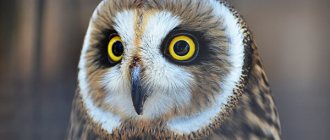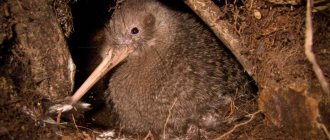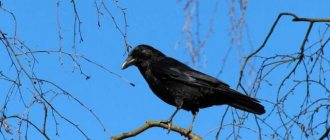- Wild animals
- >>
- Birds
Watching birds of prey, you can’t help but admire their power, lightning speed and incredible vigilance. The white-tailed eagle soaring in the air amazes with its noble, regal appearance. In addition to external features, such birds have many interesting nuances regarding their life activities. Let's try to study in detail the life style of white-tailed eagles, which can confidently be called celestial aristocrats.
Origin of the species and description
Photo: White-tailed eagle
The white-tailed eagle is a feathered predator belonging to the hawk family, the order Accipitridae and the genus of eagles. In general, all eagles are quite large predators. Their main difference from eagles is the presence of a bare (without feather cover) tarsus. The underside of the bird's fingers is equipped with small spines that help to hold prey that slips out (mainly fish).
Ornithologists distinguish 8 varieties of eagles, among which is the white-tailed eagle we are considering. It is not difficult to guess that the bird is so named because it has white tail feathers. The habitat of this species of eagles is always associated with expanses of water, so this winged predator can be found near sea coasts, large river basins, and large lakes. It is not for nothing that when translated from ancient Greek, the etymology of the word “eagle” is deciphered as “sea eagle”.
Video: White-tailed eagle
The appearance of the white-tailed eagle is very similar to its American relative, the bald eagle. Some ornithological scientists even combined them into one superspecies due to their similarity. You can also often see comparisons between the massive whitetail and the golden eagle. Currently, scientists have not identified any separate subspecies of the white-tailed eagle. These birds are majestic, proud and beautiful, which is why they are often depicted on postage stamps of different countries. As for our country, its open spaces are favored by 4 species of eagles, including the white-tailed one.
Interesting fact: The white-tailed eagle was chosen as the bird of the year in 2013 according to the Russian Bird Conservation Union. This was done in order to draw people's attention to the problems of protecting this feathered predator.
Description of the bird
This species of eagles has an unusual rough voice. This is bubbling and barking at the same time - “kyak-kyak, kra-kra...”. When they sense danger, they emit a creaking metallic screech - “kyi-kyi”... At times, a pair of feathered spouses scream together, while throwing their heads back.
Reference . The white-tailed eagle is also called the grayish eagle.
| Scientific classification | |
| Domain | Eukaryotes |
| Kingdom | Animals |
| Sub-kingdom | Eumetazoans |
| No rank | Bilaterally symmetrical |
| No rank | Deuterostomes |
| Type | Chordata |
| Subtype | Vertebrates |
| Infratype | Ghostostomes |
| Superclass | Quadrupeds |
| Treasure | Amniotes |
| Class | Birds |
| Subclass | fantail birds |
| Infraclass | New palates |
| Squad | Accipitridae |
| Family | Accipitridae |
| Subfamily | Eagles |
| Genus | Eagles |
| View | White-tailed eagle |
| International scientific name | Haliaeetus albicilla |
| The first to describe | Carl Linnaeus |
| Opened | in 1758 |
| Conservation status in the world | Least Concern |
| The Red Book of Russia | Rare view |
What does it look like
The feathered predator grows to enormous sizes. The female is larger than the male, weighing from 5 to 7 kilograms. An unusual individual lived in Scotland, its peculiarity was its weight of 8 kg. Males usually do not gain more than 4 kg. The body of the bird is oblong, up to 90 centimeters long.
The full wingspan in flight is 2-2.3 meters. The tail grows up to 40 centimeters. The coloring of the plumage is light and dark brown. The belly, neck, and head are usually paler and have a beige tint.
The tail feathers are always white, the powerful beak, like a sharp hook, is yellow. The paws are the same color as the beak, with dark claws and strong fingers. They are without feathers, which is convenient for hunting. The inside of the paws are roughened so that the prey cannot slip out.
The traces of this bird seen are striking in their size. In young individuals, the plumage, beak, and tail are initially painted in dark colors. As they grow older, at the age of 5, the feathers of the juveniles will look like those of adults.
Character and lifestyle
The white-tailed eagle returns from wintering until the water bodies are free of ice. He first chooses a nesting site. Preference is given to tall, spreading trees near a river or lake. Another condition is to stay away from human settlements. Eagles usually use their old nests, sometimes there are 2 or 3 of them.
Feathered predators are very “capricious” and cautious. If they see people near the nesting site, they may leave this place forever. The average lifespan of a white-tailed eagle is 22.25 years. Under favorable environmental conditions, even 60-year-old individuals have been recorded.
What does it eat?
The majestic bird is not picky about food. It usually feeds on marine and freshwater fish. Can safely consume cannery waste. For this reason, predators often make nests near fish processing points. If you are lucky, the eagles do not hesitate to feast on herons, ducks, and seagulls.
They hunt waterfowl all year round, especially during molting. In winter, white-tailed predators track hares. They are looking for sick and weakened animals. The predator flies up to the animal, digs in with its sharp claws, and tears the carcass apart with its beak. They can also feed on carrion.
Attention! The white-tailed eagle is considered nature's orderly. It clears the banks of reservoirs from dead fish, and the forest from corpses and infected animals.
Where does it live?
Scientists identified the first individuals of the white-tailed eagle in the 19th century, in the Baltic Republic. Now the habitat is quite wide, including Scandinavia, Japan, Iceland. It is also found everywhere in Eurasia, with the exception of the Arctic tundra and deserts. Russian nesting sites are located: along the shores of Ladoga, White, and Onega lakes.
A large colony lives off the coast of the Volga and Kama basins. In the Scandinavian countries and Iceland, these representatives of the fauna settle on rocky areas along the sea coast.
Reproduction
Nesting time occurs at 5-6 years of age. This is preceded by the mating season. The couple takes off, they begin to somersault, clutch their paws, fall like a stone, “playing catch-up.” The finished nest of a white-tailed eagle is a large, heavy structure made of tree branches, roots, and other suitable material.
Used many times, the clutch consists of 2, 3, less often 1 eggs of a dirty milky color. Incubation lasts 37-40 days. Both the female and the male participate in the process. The young fly out of the nest at 10 weeks of age.
Interesting! All their chicks usually survive. After the young leave the nest, the “mother and father” still take care of them and teach them to hunt.
Natural enemies
With such a huge size, few people dare to attack the white-tailed eagle. However, this only applies to adults. Chicks and clutches are always in danger from animal attacks. For example, in the northern and eastern territories these are brown bears.
The worst enemy for eagles is, first of all, humans. He decided that the feathered predator, with its gigantic weight and appetite, was destroying fish, muskrats with valuable fur.
Extermination began: shooting of adults, destruction of nests, destruction of the brood. This human barbarity has led to a catastrophic decline in the white-tailed eagle population.
Wintering
Southern latitudes are permanent habitats. But its northern brothers leave their habitable nests for the winter. They migrate to the territory of the Republic of China, Pakistan, and America.
This movement begins in September and October. Eagles also regularly winter along the Azov coast and the eastern Azov region. The territory of the Krasnodar Territory also attracts birds from the northern regions with its year-round warmth.
Appearance and features
Photo: White-tailed eagle bird
The white-tailed eagle is quite massive, has a powerful build, a high beak, long and wide wings and a slightly shortened tail. The coloring of males and females is completely identical, but the former are slightly smaller than the females. The weight of males ranges from 3 to 5.5 kg, females - from 4 to 7 kg. The length of the eagle's body varies from 60 to 98 cm, and its wingspan can be an impressive length (from 190 to 250 cm). These birds have well-defined feather trousers covering the lower legs; there is no feathering on the lower half of the tarsus. The bird's paws themselves are very powerful; they have sharp, large, hook-shaped claws in their arsenal, which will certainly not miss their prey.
The color of the plumage in mature birds has a heterogeneous background, which can change from brown to fawn; this difference is noticeable due to the fact that the feathers at the base are darker, and their tops look lighter (burnt out). Moving closer to the head area, the color of the eagle becomes light, almost whitish on the head itself. The coloring of the flight feathers, belly and bloomers is darker compared to the main bird background. The beautiful white tail is in contrast to the rump, undertail and wings.
The eagle's eyes are not too large, and their irises can be:
- light brown;
- brownish-brown;
- amber;
- yellowish.
For this reason, eagles are often called golden-eyed. The color of the bird's limbs and large hooked beak is also light yellow.
Interesting fact: The coloring of young animals is much darker than that of adult relatives. Their iris, tail and beak are dark gray. A series of longitudinal spots can be seen on the abdomen, and a marbled pattern is visible on the top of the tail. After each molt, young eagles become more and more similar to adult birds. Only when the birds become sexually mature do they begin to look the same as adult eagles. This does not happen before the age of five and even later.
So, a mature eagle is distinguished from other similar feathered predators by the presence of a white tail and a light head, neck and beak. The perched eagle looks short-tailed, massive and a bit shapeless when compared to an eagle. Compared to the vulture, the whitetail's head is larger. The white-tailed eagle is distinguished from the golden eagle by a shortened wedge-shaped tail and a more massive and high beak.
Where does the white-tailed eagle live?
Photo: White-tailed eagle from the Red Book
In Eurasia, the distribution area of the white-tailed eagle is quite extensive, it covers Scandinavia, Denmark, the Elbe Valley, reaching the Czech Republic, Hungary, and Slovakia. Birds inhabit the Balkans, the Anadyr basin, Kamchatka, and also live on the Pacific coast of East Asia. In the north, the eagle's habitats cover Norway, the Kola Peninsula (northern part), the Timan tundra, Yamal (southern region), then the range extends to the Gydan Peninsula, approaching the mouths of the Pesina and Yenisei, and is inhabited by eagles in the Lena and Khatanga valleys. The end of their northern range is the Chukotka Range, or more precisely, its southern slope.
In more southern regions, white-tailed eagles have chosen:
- Greece and Asia Minor;
- northern Iran and Iraq;
- lower reaches of the Amu Darya;
- northeast China;
- the northern part of the Mongolian state;
- Korean Peninsula.
White-tailed eagles liked Greenland (western part); these birds of prey also live on the territories of other islands:
- Kurilsky;
- Elanda;
- Sakhalin;
- Hokkaido;
- Iceland.
Interesting fact: In the north, the eagle is considered migratory, in the south and the central zone it is considered sedentary or nomadic. Young animals from the middle zone go south in winter, while experienced and mature eagles remain for the winter, without fear of water bodies freezing.
As for our country, the spread of white-tailed eagles across its territory can be called widespread. Most birds, relative to density, are observed in the vast expanses of Lake Baikal, the Azov region and the Caspian region. Predators most often set up their nesting sites near large inland bodies of water or on sea coasts, where they have a fairly rich food supply.
Number
The white-tailed eagle is a swift and strong bird.
The white-tailed eagle has no worthy opponents among other birds of prey. But poor ecology leads to a decrease in numbers. In addition, these predators were destroyed by local residents, mistakenly assuming that white-tailed eagles were dangerous to livestock.
In European countries in the 20th century, the population of representatives of the species sharply decreased. In the 80s, measures were developed to protect these birds. Today the situation has returned to normal and white-tailed eagles are not in danger of extinction.
If you find an error, please select a piece of text and press Ctrl+Enter.
What does the white-tailed eagle eat?
Photo: Bird of prey white-tailed eagle
The menu of the white-tailed eagle, as befits this large bird, is predatory. It, for the most part, consists of fish dishes; it is not for nothing that this bird is called the sea eagle. Fish is in the first place of honor in terms of diet; usually, eagles catch individuals no larger than three kilograms. Bird preferences are not limited only to the assortment of fish; forest game (both terrestrial and feathered) is also to the taste of eagles, and in the harsh winter they do not disdain carrion.
In addition to fish, eagles enjoy snacking on:
- hare meat;
- mole rats;
- waterfowl (ducks, geese, loons);
- marmots (baibaks);
- gophers.
Bird hunting tactics vary, it all depends on the particular type of prey and its size. The eagle can attack directly during flight, and is capable of diving on the victim from above when it looks for it in the air. Birds tend to ambush potential prey; they can also take away prey they like from another, more frail predator. White-tailed animals living in the expanses of the steppe guard gophers, marmots and mole rats right next to their burrows. The eagles quickly catch the hares that are running away. The sea eagle scares waterfowl and forces them to dive.
Interesting fact: Eagles usually feed on sick, weakened and old animals. By eating dead and dead fish, birds clean up expanses of water bodies. We should not forget that they eat carrion, so they can confidently be classified as natural feathered orderlies. Ornithological scientists assure that white-tailed animals perform the most important function of maintaining biological balance in the biotopes where they live.
Eagle behavior and nutrition
These feathered predators feed on fish, mammals and other birds. Sometimes eagles take food from other birds of prey. White-tailed eagles hunt any fish swimming near the surface of the water. Predators also attack waterbirds. During such a hunt, the eagle forces the prey to constantly dive under water until it is exhausted, then it becomes easy prey. If the caught prey is large, then the white-tailed eagle drags it to the shore directly through the water.
The eagle is a bird of northern latitudes.
There have been recorded cases of this powerful bird of prey attacking humans. In Norway in 1932, this predator attacked a 4-year-old girl playing on her parents' farm. A white-tailed eagle grabbed the girl by the dress and lifted her into the air. The bird flew with the child 800 meters to its nest, which was located on the slope of a mountain. The nest was located on a steep ledge. When the predator unclenched its claws, the girl fell not into the nest itself, but nearby. The child was very lucky; the dress got caught on a rock, and the baby hung in the air. An instantly formed rescue squad went to help the child. The girl was safely rescued and had only minor bruises and abrasions. And the dress became a real heirloom; representatives of the family still keep it.
The bird's appearance is stern, as is its character.
Features of character and lifestyle
Photo: White-tailed eagle in flight
The white-tailed eagle is the fourth largest winged predator in European territory. In front of him are: a griffon vulture, a bearded vulture and a black vulture. Whitetails are monogamous; when paired, they live for decades in the same territory, which can extend over a distance of 25 to 80 km. The family of eagles carefully protects their possessions from other competitors. In general, it is worth noting that the character of these birds is quite harsh; they do not even bother with their young for a long time and immediately accompany them to an independent life as soon as they begin to fly.
When eagles hunt fish, they vigilantly look out for prey and immediately swoop down from above to pick it up with the help of sharp claws on their feet. A predator can even hide in the water surface for a split second in order to catch fish from the depths; I have complete control over this situation. In flight, eagles are not as spectacular and swift as falcons and eagles. Compared to them, they look heavier and float much less often. Their wings are blunt and have almost no curves characteristic of eagles.
An eagle sitting on a branch is very similar to a vulture; it also lowers its head and has ruffled plumage. The voice of eagles is distinguished by a high, slightly rough screech. When birds are disturbed by something, their cry becomes more abrupt with the presence of a certain metallic creak. Sometimes a pair of eagles form a screaming duet. The birds simultaneously squawk, throwing back their heads.
Hunting tactics
A white-tailed eagle slowly circles around a pond for a long time and looks out for fish. Having noticed the target, he falls down in front of his paws with lightning speed. With sharp claws, the bird grabs prey from the water and carries it to the shore or absorbs it directly in the air. The victim does not have time to go to depth and escape from the bird.
The hunting style depends on the type of prey. If there is a dead fish on the shore, white-tailed eagles slowly fly up to it.
The birds look out for hares, gophers and geese from the air and sharply dive at them. Or they keep watch on a branch, waiting for an opportunity.
Often, white-tailed eagles take away the prey of their weaker counterparts.
Social structure and reproduction
Photo: White-tailed eagle in Russia
As already noted, eagles are supporters of strong marriage bonds, forming a pair for life. A family bird couple always goes together to winter in warm regions and returns together to their native nest; this happens in March or April. The nesting area of eagles is a real family estate for the birds, where they live throughout their lives, completing and repairing their home, if necessary. Eagles choose nesting sites on trees growing along lakes and rivers, or on cliffs and rocks, also located near water.
To build a nest, feathered predators use thick branches, and the bottom is lined with bark, thinner twigs, tufts of grass, and feathers. Such a massive structure is always located on a large and strong branch or in the area of a fork in the branches. One of the main conditions is the placement height, which can vary from 15 to 25 m; this protects the chicks from ground-based enemies.
Interesting fact: When the nesting box is just built, it does not exceed one meter in diameter, but over the years it becomes larger and heavier, gradually increasing in size by a couple of times. Such a structure can easily collapse from its own weight, so whitetails often have to start building a new home.
The female can lay from 1 to 3 eggs, most often there are 2. The color of the shell is white, and there may be ocher spots on it. The eggs are large enough to match the birds. They are 7–8 cm long. The incubation period is about five weeks. Chicks are born in May. For about three months, parents take care of their offspring, who are in great need of their care. Already at the beginning of the last summer month, young eagles begin to take wing, and towards the end of September they leave their parental home, setting off for adult, independent life, which in natural conditions can range from 25 to 27 years.
Fun Fact: Amazingly, captive white-tailed eagles can live over 40 years.
Lifestyle
This bird is diurnal. Bald eagles do not form nesting settlements; they nest at a distance of at least 1 - 2 km. Often their distribution depends on the presence of large trees that are capable of supporting massive nests.
Some bald eagle nests are enormous in size and can eventually reach 3 m in diameter as they are built up each year.
During the wintering grounds, these birds can gather in dozens of individuals in a place, especially near fish-breeding enterprises, in ports, and landfills.
Natural enemies of the white-tailed eagle
Photo: White-tailed eagle
Due to the fact that the white-tailed eagle is a large and strong feathered predator with an impressive beak and tenacious claws, it has almost no ill-wishers in the wild. But this can only be said about mature birds, but newborn chicks, inexperienced young and eggs of eagles are the most vulnerable and can be harmed by other predatory animals that are not averse to feasting on them.
Sakhalin ornithologists have found that a large number of bird nests suffer from the paws of brown bears, this is evidenced by the presence of certain scratches on the bark of trees where eagles settle. There is evidence that in 2005, young bears destroyed about half of the birds' homes, thereby destroying their offspring. Thieving raids on nests can also be carried out by representatives of the weasel family, which also move deftly in the tree crown. Corvids can also harm the clutch.
Sadly, one of the worst enemies of eagles until quite recently was man, who in the middle of the last century began the targeted extermination of these majestic birds, considering them the main competitors for the possession of fish and muskrats. In this unequal war, a large number of not only adult eagles died, but also their clutches and chicks were destroyed. Now the situation has changed, people have counted whitetails among their friends.
All the same, birds continue to suffer from human actions, falling into traps set by hunters for other animals (up to 35 birds die because of this per year). Often, large influxes of tourist groups force birds to migrate to other territories, which negatively affects their livelihoods. It also happens that simple human curiosity leads to tragedy, because a bird immediately abandons its clutch if a person touches it, but it itself will never attack a biped.
Habitat
Estonia is considered the birthplace of the eagle. But at the moment, the white-tailed bird is a fairly common bird and is found almost throughout the entire territory of Eurasia, with the exception of the Arctic tundra and deserts.
The eagle settles in forests near bodies of water that abound in fish and as far as possible from human habitat. The sea eagle can also be found in coastal areas.
White-tailed eagle
Population and species status
Photo: White-tailed eagle bird
The situation with the population status of white-tailed eagles is ambiguous; in some places it is considered a common species, in other territories it is considered vulnerable. In the vastness of Europe, the distribution of the sea eagle is considered sporadic, i.e. uneven. There is information that about 7,000 bird pairs nest in the territories of Russia and Norway, which is 55 percent of the entire European bird population.
European data indicate that the number of pairs that actively breed varies from 9 to 12.3 thousand, which is commensurate with 18 to 24.5 thousand mature individuals. Ornithological scientists note that the number of white-tailed eagles is slowly, but still increasing. Despite this, there are many negative anthropogenic factors that have a detrimental effect on the existence of these mighty birds.
These include:
- degradation and drainage of wetlands;
- the presence of a whole range of environmental problems;
- cutting down large old trees where eagles prefer to nest;
- human intervention in natural habitats;
- insufficient food supply due to the fact that people catch fish en masse.
It must be repeated and noted that in some regions and countries, eagles are considered vulnerable species of birds, and therefore require specialized protection measures, which people are trying to provide for them.
Extermination
Humanity has long worked to exterminate white-tailed eagles. It was believed that this was a dangerous bird that caused damage to fisheries because it fed on river inhabitants. Birds were also blamed for the decline of their waterfowl relatives. Destruction occurred in different ways:
- shooting;
- destruction of old large trees on which nests were located;
- pollution of rivers and lakes;
- displacement from habitats.
Therefore, by the beginning of the 20th century, white-tailed eagles disappeared from their usual habitats. Several decades later, the birds were “acquitted,” and a ban on their shooting was introduced. In some countries, the population of the endangered species has been partially restored, but it still remains quite rare. Today, shooting does not threaten the birds, but poor ecology has a very negative effect on the growth of their numbers .











